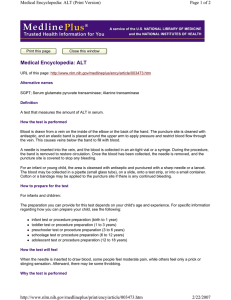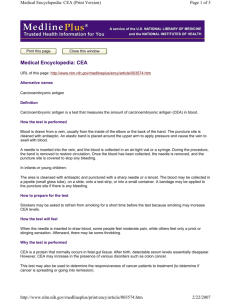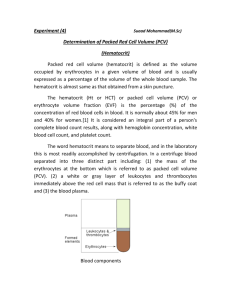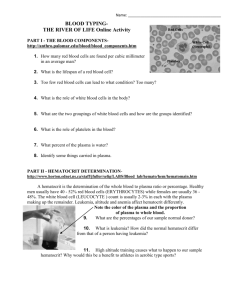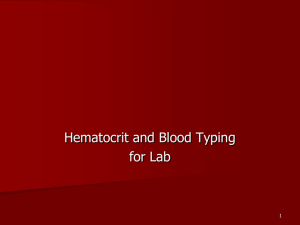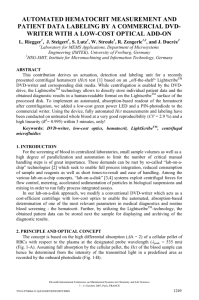Medical Encyclopedia: Hematocrit (HCT) Page 1 of 3
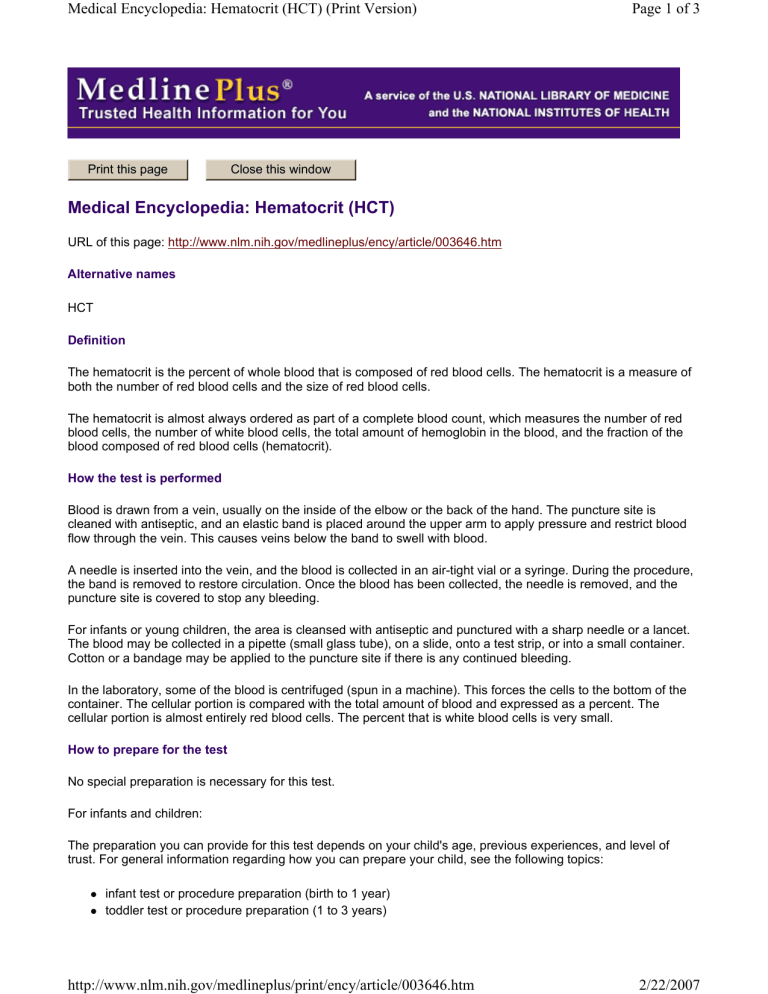
Medical Encyclopedia: Hematocrit (HCT) (Print Version) Page 1 of 3
Print this page Close this window
Medical Encyclopedia: Hematocrit (HCT)
URL of this page: http://www.nlm.nih.gov/medlineplus/ency/article/003646.htm
Alternative names
HCT
Definition
The hematocrit is the percent of whole blood that is composed of red blood cells. The hematocrit is a measure of both the number of red blood cells and the size of red blood cells.
The hematocrit is almost always ordered as part of a complete blood count, which measures the number of red blood cells, the number of white blood cells, the total amount of hemoglobin in the blood, and the fraction of the blood composed of red blood cells (hematocrit).
How the test is performed
Blood is drawn from a vein, usually on the inside of the elbow or the back of the hand. The puncture site is cleaned with antiseptic, and an elastic band is placed around the upper arm to apply pressure and restrict blood flow through the vein. This causes veins below the band to swell with blood.
A needle is inserted into the vein, and the blood is collected in an air-tight vial or a syringe. During the procedure, the band is removed to restore circulation. Once the blood has been collected, the needle is removed, and the puncture site is covered to stop any bleeding.
For infants or young children, the area is cleansed with antiseptic and punctured with a sharp needle or a lancet.
The blood may be collected in a pipette (small glass tube), on a slide, onto a test strip, or into a small container.
Cotton or a bandage may be applied to the puncture site if there is any continued bleeding.
In the laboratory, some of the blood is centrifuged (spun in a machine). This forces the cells to the bottom of the container. The cellular portion is compared with the total amount of blood and expressed as a percent. The cellular portion is almost entirely red blood cells. The percent that is white blood cells is very small.
How to prepare for the test
No special preparation is necessary for this test.
For infants and children:
The preparation you can provide for this test depends on your child's age, previous experiences, and level of trust. For general information regarding how you can prepare your child, see the following topics: z z infant test or procedure preparation (birth to 1 year) toddler test or procedure preparation (1 to 3 years) http://www.nlm.nih.gov/medlineplus/print/ency/article/003646.htm
2/22/2007
Medical Encyclopedia: Hematocrit (HCT) (Print Version) Page 2 of 3 z z z preschooler test or procedure preparation (3 to 6 years) schoolage test or procedure preparation (6 to 12 years) adolescent test or procedure preparation (12 to 18 years)
How the test will feel
When the needle is inserted to draw blood, some people feel moderate pain, while others feel only a prick or stinging sensation. Afterward, there may be some throbbing.
Why the test is performed
The hematocrit indicates the proportion of cells and fluids in the blood.
Normal Values
Hematocrit (varies with altitude): z z
Male: 40.7-50.3%
Female: 36.1-44.3%
What abnormal results mean
Low hematocrit may indicate: z z z z z z z z anemia (various types) blood loss (hemorrhage) bone marrow failure (e.g., due to radiation, toxin, fibrosis, tumor) destruction of red blood cells leukemia malnutrition or specific nutritional deficiency multiple myeloma rheumatoid arthritis
High hematocrit may indicate: z z z dehydration
{ burns
{ diarrhea erythrocytosis (excessive red blood cell production) polycythemia vera
This test may be performed under many other conditions and in the assessment of many disease states.
What the risks are z z z z z excessive bleeding fainting or feeling light-headed hematoma (blood accumulating under the skin) infection (a slight risk any time the skin is broken) multiple punctures to locate veins
Special considerations http://www.nlm.nih.gov/medlineplus/print/ency/article/003646.htm
2/22/2007
Medical Encyclopedia: Hematocrit (HCT) (Print Version) Page 3 of 3
Veins and arteries vary in size from one patient to another and from one side of the body to the other. Obtaining a blood sample from some people may be more difficult than from others.
Update Date: 2/3/2005
Updated by: Rita Nanda, M.D., Department of Hematology/Oncology, University of Chicago Medical Center, Chicago, IL. Review provided by
VeriMed Healthcare Network.
A.D.A.M., Inc. is accredited by URAC, also known as the American Accreditation HealthCare Commission (www.urac.org). URAC's accreditation program is the first of its kind, requiring compliance with 53 standards of quality and accountability, verified by independent audit. A.D.A.M. is among the first to achieve this important distinction for online health information and services. Learn more about A.D.A.M.'s editorial process . A.D.A.M. is also a founding member of Hi-Ethics (www.hiethics.com) and subscribes to the principles of the Health on the Net Foundation (www.hon.ch).
The information provided should not be used during any medical emergency or for the diagnosis or treatment of any medical condition. A licensed physician should be consulted for diagnosis and treatment of any and all medical conditions. Call 911 for all medical emergencies.
Adam makes no representation or warranty regarding the accuracy, reliability, completeness, currentness, or timeliness of the content, text or graphics. Links to other sites are provided for information only -- they do not constitute endorsements of those other sites. Copyright 2005,
A.D.A.M., Inc. Any duplication or distribution of the information contained herein is strictly prohibited. http://www.nlm.nih.gov/medlineplus/print/ency/article/003646.htm
2/22/2007
